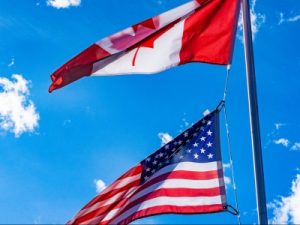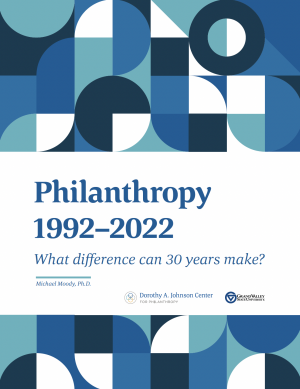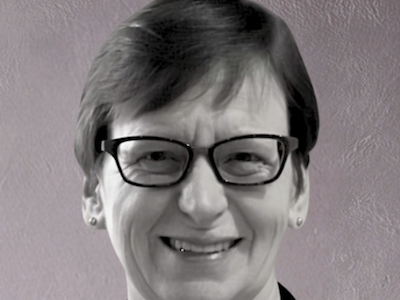A recent report, “Philanthropy 1992–2022: What difference can 30 years make?”, looks at how things have changed in charitable giving and philanthropy in the US. Mega-donors have become much more mega for example. Diversity, inclusion, equity and justice became prominent concerns. Reinventing government made it an even larger source of nonprofit revenues. Measuring outcomes became the norm, and evaluation became a widespread practice of a new and more strategic philanthropy. More degrees and academic centers were created as the research field of philanthropy matured.
The report, by Dr. Michael Moody (Frey Foundation Chair for Family Philanthropy at the Dorothy A. Johnson Center for Philanthropy, at Grand Valley State University, Michigan), can serve as a great discussion piece for Canadian philanthropy.
But how closely does Canada really mirror the US?
 Because so much of the research about philanthropy is US based, we tend to assume that Canada follows similar patterns. But does it? In what ways is Canadian philanthropy and the charitable sector distinctive from the US (or Europe or elsewhere)? We don’t know exactly, because we aren’t conducting enough research to fully understand Canadian philanthropy and the challenges it faces, but based on the limited analysis available for Canada, there are some similar trends to those identified in the report – and some stark differences.
Because so much of the research about philanthropy is US based, we tend to assume that Canada follows similar patterns. But does it? In what ways is Canadian philanthropy and the charitable sector distinctive from the US (or Europe or elsewhere)? We don’t know exactly, because we aren’t conducting enough research to fully understand Canadian philanthropy and the challenges it faces, but based on the limited analysis available for Canada, there are some similar trends to those identified in the report – and some stark differences.
Some commonalities between Canadian and US philanthropy
Five similarities are apparent:
- the number of charities has increased (by 151% in the US since 1995 and 25% in Canada since 2000);
- donor advised funds (DAFs) have grown dramatically;
- the percentage of giving to religion has dropped;
- the role of community foundations has shifted from being ‘philanthropic banks’ serving donors to being community leaders and voices, although many Canadian community foundations have long been community leaders, not just facilitators for donors; and
- while this seems less significant or less reported in Canada, the sector still struggles to address inclusion, equity and justice (with Moody noting there is some backlash to ‘woke philanthropy’ in the US).
There are also at least four important differences between us
All four demonstrate the danger of using US data to guide our understanding of Canadian philanthropy.
1. Individual giving trends differ in Canada and the US
 In the US, the mix of giving has shifted from individuals to foundations. Individuals are still the largest source of charitable giving, but their share of total giving has dropped to about two thirds. This relative decline is not due to less giving by individuals, as this has continued to grow. Rather, foundation giving has risen significantly, increasing its share of an expanded philanthropic pie (total giving increased almost four-fold in the past 30 years).
In the US, the mix of giving has shifted from individuals to foundations. Individuals are still the largest source of charitable giving, but their share of total giving has dropped to about two thirds. This relative decline is not due to less giving by individuals, as this has continued to grow. Rather, foundation giving has risen significantly, increasing its share of an expanded philanthropic pie (total giving increased almost four-fold in the past 30 years).
In Canada, the role of foundations has also expanded, to approximately 11,000, an increase of 44%. Also, their assets increased by 33% from 2000 to 2021 (from $93 billion to $123 billion). In contrast to the US, individual giving has declined in Canada, and it was already behind the US. As a percentage of GDP, Canadians give less than half as much as Americans (0.77% compared to 2% of GDP).
Also, whereas 25% of taxfilers in Canada claimed charitable donation credits in 2006, only 18.4% did so in 2020. As noted in the CanadaHelps 2022 Giving Report, the decline in giving is across the board, except, surprisingly, for those earning less than $20,000 per year. The decrease in the amount donated is steepest among families with incomes of $150,000 or more. High Net Worth households (those with more than $1 million in wealth, excluding real estate and businesses) still account for a substantial amount of total donations, as they make relatively larger gifts, but this group isn’t giving in accord with their capacity to do so.
Why is Canada seemingly going in a different direction than the US in individual giving and what can we do about it? We don’t know because we don’t have the research capacity to fully analyze it.
2. Canada has few mega donors or flashy philanthropists getting media attention
While Canadians made multi-million-dollar gifts in recent years, primarily to health care, these tend to be smaller than in the US, and there isn’t (perhaps thankfully) the domestic equivalent of a Jeff Bezos giving $100 million to a country singer-songwriter to support her charitable work. While we might forgo the flash, the seeming lack of interest by Canadian media in reporting on the generosity of home-grown donors and on philanthropy more generally contributes to its lack of visibility and understanding of its impact.
3. Infrastructure and philanthropy-serving organizations have a greater presence in the US than in Canada
The report notes that the US now has “dozens and dozens of regional associations of grantmakers, national affinity groups, capacity building organizations, and other support organizations and membership associations — even associations of those associations.” In Canada, national associations supporting philanthropy, notably PFC, CFC, CAGP, AFP and Environmental Funders, have strengthened over the past decade.
In contrast, infrastructure organizations serving charities and nonprofits have a much tougher time attracting sustainable funding and their weaker organizational strength hinders capacity building across the sector. If Canada’s philanthropic and nonprofit sector is to have a more effective policy voice and create greater public awareness, it needs to grow its own infrastructure. (Ideas on how to do so and to create stronger cross-sector leadership are invited here, in a initiative in Canada.)
4. Research and education for the sector is vastly under-developed in Canada
 While the report laments that several of the early, large academic research centres have closed, there are still 274 universities with graduate degrees and 50 research centres in the philanthropy/nonprofit field in the US, many of them funded by foundations or individual donors. Indeed, Moody has a named professorship in a named research centre on philanthropy. By contrast, there is only one graduate program in this field in Canada – the Master of Philanthropy and Nonprofit Leadership (MPNL), at Carleton University – and there’s no significant philanthropic funding for a research centre or school of philanthropy that could help the sector to address the major changes that lie ahead and that could help to develop the skilled, diverse leadership that the sector needs.
While the report laments that several of the early, large academic research centres have closed, there are still 274 universities with graduate degrees and 50 research centres in the philanthropy/nonprofit field in the US, many of them funded by foundations or individual donors. Indeed, Moody has a named professorship in a named research centre on philanthropy. By contrast, there is only one graduate program in this field in Canada – the Master of Philanthropy and Nonprofit Leadership (MPNL), at Carleton University – and there’s no significant philanthropic funding for a research centre or school of philanthropy that could help the sector to address the major changes that lie ahead and that could help to develop the skilled, diverse leadership that the sector needs.
“The practice of philanthropy will continue to throw out new twists and challenges for the study of philanthropy. We will continue to need well-trained and credentialed professionals to work in this ever-more-complicated field.” –“Philanthropy 1992–2022: What difference can 30 years make?” by Dr. Michael Moody
A new vision
We need to better understand what is distinctive about Canada versus the US in trends in giving and in the sector, and to use this knowledge for a more impactful philanthropy and stronger charitable sector. This is behind Carleton University’s MPNL vision for a major research and training hub, working in collaboration with and for the sector. We hope that audacious philanthropists who share this vision will join us in exploring the possibilities.
Find out more with an email to me (susan.phillips@carleton.ca).
Susan D. Phillips is Professor and Graduate Supervisor of the Philanthropy and Nonprofit Leadership program at Carleton University.
Saturday, November 26, 2022 in For homepage, News & Events, Trends, US Policy
Share: Twitter, Facebook
 By
By 


